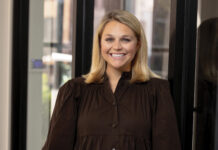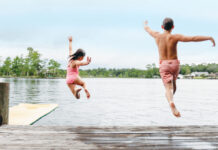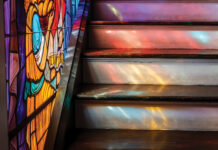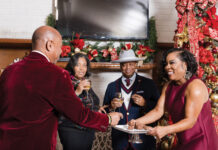

Both arms ached, and my right lat muscle was seizing with cramps. I had to raise my right arm above my head to get it to relax. I was sitting on a paddleboard in the center of Mobile Bay, working to keep my fear from taking control, breathing deeply, trying to remain calm.
When I paddled again, the seizing muscle returned. It took 10 minutes of rest to calm it, during which the north wind pushed me too far south. To make up for lost ground, I headed hard northeast. I was now alternating paddling seated for 20 minutes, kneeling for 20 minutes and standing for 20 minutes. Each different position offered different muscle usage, giving different muscles a small break. I was tired. And I was more than a little worried.
Was it time to call for help?
An Idea is Born
Last July, I determined that I’d paddleboard across Mobile Bay — or try to, at least. The challenge would test me, and I could use a test like this. I shared my intentions with lots of people. I reasoned that with so many people aware of my goal, it would hold me accountable to achieving it. I hadn’t been on a paddleboard in 10 years or more. My balance, critical to paddleboarding, is average at best, and I didn’t even own a paddleboard or paddle. I began laying out a plan.
Using Google Earth and estimating how fast I could paddle, I figured I’d need to paddle with good strength for just shy of four hours. I was wrong. Way wrong.
I was inspired by the Molokai to Oahu paddleboard race I had seen on social media. It’s a 32-mile open-water challenge that happens every July between the Hawaiian island of Molokai and an Oahu beach. Videos of these athletes plowing over and through huge swells was awe inspiring. Certainly, if these people can paddle 32 miles over the deep, open Pacific Ocean (the Ka’iwi Channel is 2,300 feet deep), I can go 11 miles over the calm, shallow waters of Mobile Bay. Unlike the Molokai to Oahu competition, where the event date is fixed on the calendar, I could pick my crossing day when I found the weather I wanted, and I could train until I felt ready. Because of this flexibility, this would be a good challenge, I told myself, and it wouldn’t be too hard. It would force me through the fear of being alone on open water — there would be no paddle partner and no chase boat — and train me to do something unknown. This is the good type of fear.
Yet the ultimate question haunted me: Can I actually do this? Do I have what it takes? Do I have the mental and physical discipline to plan for the crossing, train consistently and appropriately, start paddling at Dog River and finish on the eastern shore of Mobile Bay at the Grand Hotel? It’s 10.8 miles as the crow flies. With adjustments and course corrections along the way, I expected it to be nearly a 12-mile paddle.
Jimbo Meador loaned me his Dragonfly paddleboard designed as a fishing board. It was wide and long with a shallow keel to allow it to float over very shallow water. It was stable, which I needed, but it was also heavy — at 65 pounds it is about three times as heavy as newer board models. The shallow keel meant that when I paddled, it was easy to get off target, and I’d need to switch paddling sides frequently. Clint Jameson with Adventure Earth rented me an adjustable paddle and sized it to my height. Then it was time to train.
August 18, 2024
I shoved away from land at Memories Fish Camp near the headwaters of Fowl River around 8 a.m. This would become my training water. Fowl River would be calm. At no point was I too far from the water’s edge if something went wrong.
I paddled about an hour that day — about two miles of slow, very deliberate and wobbly paddling. When I passed the only other boat I saw, they called out “Good morning” and I nearly fell. I smiled instead of replying. I’d have to wait to learn to both talk and stand on a paddleboard at the same time — I wasn’t quite there yet.
August 30
Out of bed at 5:05 a.m. The board was strapped to my car and the paddle was inside. I was on the water at Fowl River shortly after 6 a.m. My goal was to reach three hours of paddling. I had achieved two hours the weekend before and felt good when I finished. Three hours should be reachable.
Twenty minutes into the paddle, a giant whoosh disrupted the water about a foot from my board. The board rocked, and I struggled to stay standing where whatever made the whoosh was now below me. The boil in the water was about four feet in diameter — whatever caused it was huge. The week before, I had asked local Fowl River expert Sam St. John if there were any alligators in the river. “Oh yes,” he nodded. “Plenty of them.” Was it an alligator that had caused the water to jump? A manatee? A gar? A bull shark? I paddled to the nearest bulkhead, dropped to my knees and looked back. The water was still churning.
Not knowing what to do, I looked at my phone and noticed the threat of weather to the south and saw an anvil-shaped cloud forming. That was all the excuse I needed. I turned around and headed back to the launch, sprinting over the spot where the big creature had been. I was loading the paddleboard onto my car 20 minutes later in the rain. The three-hour goal would have to wait.
September 14
I left Memories Fish Camp at 8:20 a.m. I was feeling strong. Getting to my feet on the board was getting easier, and I’d only fallen twice in all my training — most recently when a boater slowed down next to me, swamping me with its wake.
At 90 minutes, I turned around on the eastern side of Bellingrath Gardens in a wide part of the river. There was now a slight headwind, and the tide was going out, running against me. This will be a good test, I told myself.
In the third hour, something happened. I grew suddenly weak and had to drop to my knees. With the headwind and the current against me, I was still far from my starting point. My vision began to blur and fade, and I was unable to see color. Everything went white except for a small hole in the center of my vision where I could make out broad shapes.
Could this be a stroke? Another one? I had no life jackets. I was afraid to grab for my phone for fear of fumbling and dropping it.
I paddled to land and sat until my vision slightly recovered, then pushed back into the water and, from my knees, slowly paddled another 40 minutes to the launch. The distance between the last Fowl River no-wake sign and the Memories Fish Camp launch usually takes 10 minutes to paddle. This time, it took 30. I asked a fisherman launching his boat for help loading the board since I was too weak to do it alone. I sat in my car another 30 minutes until my vision was good enough to drive, then headed straight to Greer’s in Bayley’s Corner and bought an armload of fruit and Gatorade.
A doctor told me it was likely a severe blood sugar deficiency, and I should paddle with apples and peanut butter next time — along with lots of water — to keep my blood sugar up. Noted.
October 13
I paddled the length of Fowl River, from Memories Fish Camp to the Fowl River marina. I ate apple slices and peanut butter along the way and never felt weak. I was ready to make the crossing, I thought. I felt confident and strong in the water.
Then my work travel schedule took off. I was on airplanes and in hotel rooms for most of the fall. During the Christmas holidays, it was simply too cold to be on the water, and then spring vanished with Mardi Gras activities. The paddleboard beckoned from the garage. I wondered if I had what it took to resume this challenge, or would I find excuses not to try?
April 12, 2025
It had been six months since I was last on the paddleboard. I carried the board on my head from the Memories Fish Camp parking lot to the edge of Fowl River where, at the water’s edge, my flip-flop hit slippery mud. I didn’t fall straight down. In a quirk of physics, I gained altitude before beginning my fall. My lower back left a crater in the mud, and I struggled to get out from under the paddleboard. I launched wearing a blue t-shirt caked in Fowl River mud.
Three hours later, I asked a kayaker to help me carry my board to the car. He walked to the water’s edge, and just as he got to my board — in the very same spot — his feet shot out from under him. He ascended and crashed on his back in the very same crater my back had made earlier. It’s a tricky spot.
With a solid three-hour paddle completed, I was as ready as I’d ever be, though one more three-plus hour paddle would add to my confidence. It would never happen.
The spring of 2025 in south Alabama proved breezier than any I could recall. Looking for days to practice or days to cross the Bay, the wind was always a problem. I wanted a light wind from the west, enough to help move me over the water but not so strong it would create chop on the Bay. Later in the week of May 26, a series of storms blew through, and when the weather cleared, it left blue skies and a breeze from the north. Saturday would be the day. I was tired of putting it off. Though not a west wind, a north wind would help once I cleared Gaillard Island. This would have to be it.

May 31—The Crossing — 10:40 a.m.
My wife and I found a small beach at the end of Park Road just north of the Dog River bridge. We set up the paddleboard, and I shoved off to the east. The wind was blowing but should eventually die down. I decided to launch at the high point of the day’s wind when I’d have my strength. By the time I weakened, so would the wind, and I’d have to fight it less.
Ahead of me was nearly 11 miles of Mobile Bay to cross and the curvature of the earth to overcome. It’s the reason I can see only the treetops on the other side — no roofs, no wharves, certainly not the Grand Hotel. I get to my feet and take my first big stroke. “This crossing may be a non-event. We’ll see,” I call to my wife over my shoulder. I point the paddleboard northeast to account for the wind and start.
I hadn’t realized how much the wind would push me. Though the tide was coming north, the wind was blowing me south, and the wind was winning. To move easterly across the Bay, I had to point the board well to the northeast — roughly at what I guessed was the Spanish Fort Hampton Inn just off I-10 — to keep moving east. It required 15 to 20 strong strokes on the right side of the board, then three light strokes on the left to go straight. Eventually, I passed the Dog River channel markers and then came even with the western edge of Gaillard Island.
My lower back was on fire. Paddling primarily on one side of the board was not something I had prepared for. Whenever I paddled on the left, I could feel my back ease, but paddling repeatedly on the right into the wind brought lower back pains I hadn’t experienced in my Fowl River practices.
11:30 a.m.
I still had not cleared Gaillard Island. The wind had not died down much. Now on the horizon was what appeared to be the top of a tall, rectangular building about where I guessed the Grand Hotel to be. I made this my new target but was still having to point the board northeast to account for the north wind. In an hour, I might be able to turn south a bit and let the wind offer a hand.
12:30 p.m.
I finally cleared Gaillard Island. The rectangular building was still visible and still my target. The wind was slacking but hadn’t stopped. My legs were feeling it. The waves were causing the board to wobble more than anything I had experienced on Fowl River, and the small muscular adjustments to stay standing were being absorbed in my thighs, which were now on fire. This was new pain. I estimated I was about halfway.
1:30 p.m.
I thought I could see where the land on the Eastern Shore formed a point to my south, which would be the Grand Hotel. On the eastern side of Mobile Bay, there were many fewer pilings or crab trap buoys for me to use to judge my speed. In the past hour, it didn’t feel like I’d made any headway. The wind had slowed a bit, but the current was still coming in. Could it be that the current was now winning and that, regardless of my paddling, I was floating north, not southeast toward my target?
I reminded myself not to let my brain get out of control. My guess was that the paddle would now take four hours. My left triceps and right shoulder were beginning to cramp. The nearest land was the Fairhope beach, however getting there would require me paddling directly perpendicular to the wind, and I no longer had that strength. I headed further south. Though a longer paddle, it would let the wind push me toward the hotel. “You’re OK,” I kept repeating to myself.
2:00 p.m.
I was slowly getting closer. I had to be. I thought I noticed the features of the hotel coming into view. Or maybe I was imagining progress. My arms hurt and I was questioning what I had started. Why even do this?
My memory of being helpless during a stroke from a blood clot in my head in March of 2023 wouldn’t go away. I fully recovered from it thanks to lots of luck and my doctors’ expertise. It was an awful event, and the memory of that helplessness has nagged at me. I wanted to feel like I was in control of my body again. And to regain that feeling, I settled on this challenge that would put me into unfamiliar territory — something that would generate the fear that makes you feel more alive, not the fear of being helpless to circumstances beyond your control.
“Why?” was the question most people asked when I told them what I was up to. And saying, “To feel more alive” is a corny answer. But it’s the truth. I ended up saying, “Just to see if I can do it” as the standard reply which generated lots of shaking heads. My wife sensed that I was committed and never tried to talk me out of it. My friends offered to escort me with their boats, and I turned them all down. I wanted to do it alone, I wanted to feel exhausted, I wanted a feeling of accomplishment and, along the way, I wanted to feel a bit of fear.
2:20 p.m. — 4 hours of paddling
More of the Grand Hotel’s features were coming into view, but somehow it felt like I wasn’t moving. My wife told me she could see my movement on her phone app, that I was headed in the right direction. None of the key landmarks — the Grand Hotel in particular — appeared to be getting any closer. My arms and shoulders were exhausted. I’d eaten all my apples and was nearly out of water. This whole thing was a bad idea.
3:20 p.m.
My watch battery died. It last showed that I’d paddled for five hours, travelling 10.8 miles at an average of 2 miles per hour. My heart had been beating at 150 bpm the whole time. 2,800 calories burned, with still a ways to go.
3:44 p.m.
I paddled the last stretch of water on my knees, counting out 100 paddles, then falling forward onto my hands to rest. Three hundred paddles later, I could hear my wife calling to me from the marina bulkhead. Her video shows weak paddles, no strength left. The paddleboard touched the sand at the small marina just north of the Grand Hotel. I sat on the board for 20 minutes while my arms and legs trembled. My wife brought me Gatorades and bananas. Gradually, I was able to stand. We lifted the board onto the car and strapped it down for the ride back to Mobile.
Looking Back
I frequently tell my children that they are capable of doing hard things. Usually, I say this sitting in my comfy morning chair drinking a coffee or, later in the day, having a glass of wine. What I’m saying versus what I’m doing stands in stark contrast with one another, and this dissonance has often made me wonder if I am still capable of doing hard things.
My stroke put me on the mat. It scared me. I was not in control. Having the will to live and survive is not a hard thing. It’s automatic; it’s built in. I needed to do something hard to remind me that I am, today, capable of doing hard things. And I did it. Despite the exhaustion I felt that afternoon and poor sleep that night due to twitching muscles and a fatigue that wouldn’t allow me to relax, I was tremendously proud of myself. And I still am.
The next day, my brother Dale met me at Jimbo Meador’s house to help me unload the board. I’d washed and waxed it, and Dale and I put it on its stand under the eave of Jimbo’s garage. Jimbo congratulated me. “That’s quite an accomplishment,” he said. “The board is here if you ever want to use it again.”
Nope. I’m done with that. Glad I did it, but never again. Paddling across the Bay scared me a bit. But it was just the amount of fear that I needed.
Cam Marston records weekly commentaries for Alabama Public Radio that broadcast Fridays during drive time. He has a podcast, runs a seminar company, and is a top-rated keynote speaker focusing on workplace and workforce trends.





